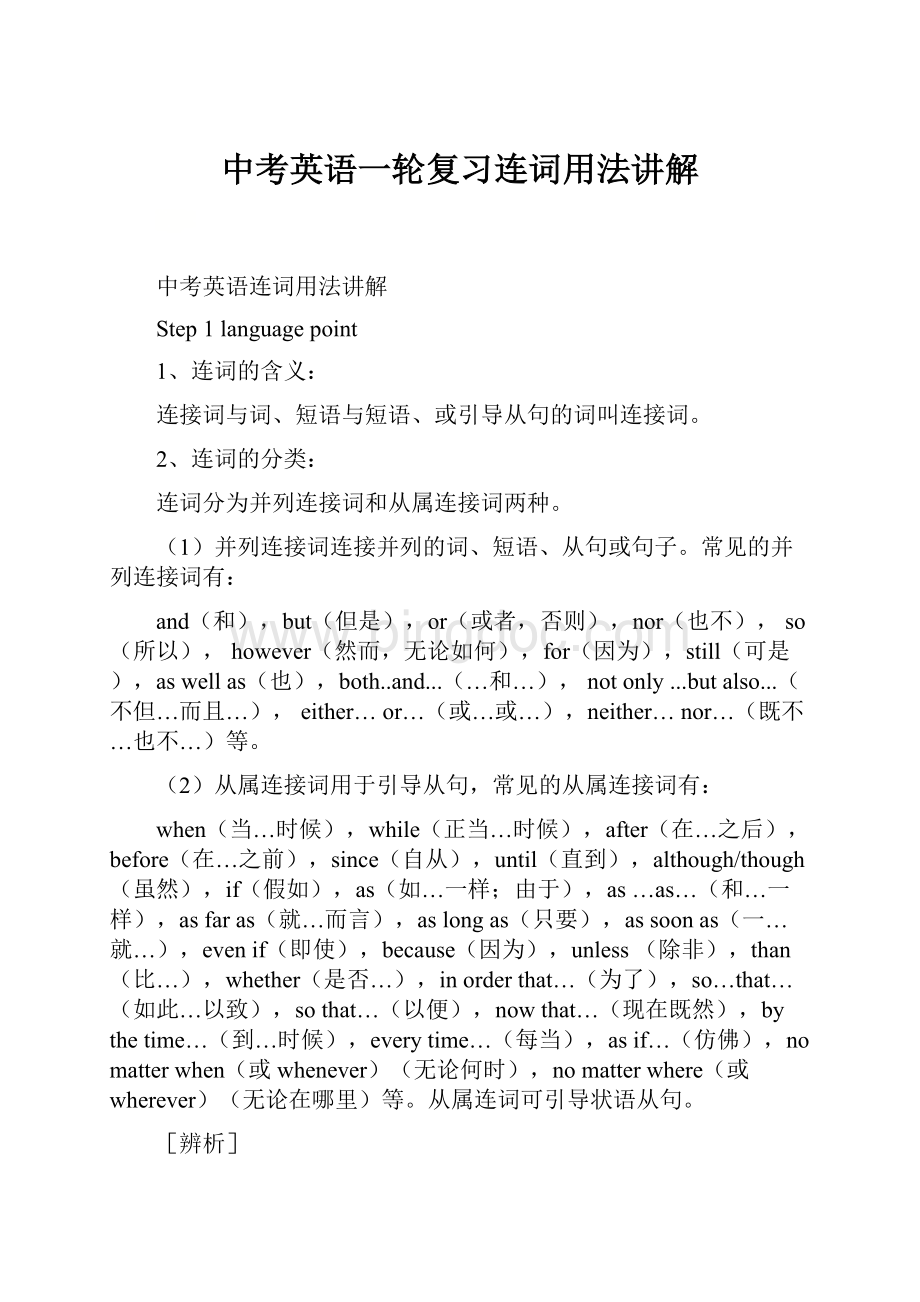中考英语一轮复习连词用法讲解.docx
《中考英语一轮复习连词用法讲解.docx》由会员分享,可在线阅读,更多相关《中考英语一轮复习连词用法讲解.docx(18页珍藏版)》请在冰点文库上搜索。

中考英语一轮复习连词用法讲解
中考英语连词用法讲解
Step1languagepoint
1、连词的含义:
连接词与词、短语与短语、或引导从句的词叫连接词。
2、连词的分类:
连词分为并列连接词和从属连接词两种。
(1)并列连接词连接并列的词、短语、从句或句子。
常见的并列连接词有:
and(和),but(但是),or(或者,否则),nor(也不),so(所以),however(然而,无论如何),for(因为),still(可是),aswellas(也),both..and...(…和…),notonly...butalso...(不但…而且…),either…or…(或…或…),neither…nor…(既不…也不…)等。
(2)从属连接词用于引导从句,常见的从属连接词有:
when(当…时候),while(正当…时候),after(在…之后),before(在…之前),since(自从),until(直到),although/though(虽然),if(假如),as(如…一样;由于),as…as…(和…一样),asfaras(就…而言),aslongas(只要),assoonas(一…就…),evenif(即使),because(因为),unless(除非),than(比…),whether(是否…),inorderthat…(为了),so…that…(如此…以致),sothat…(以便),nowthat…(现在既然),bythetime…(到…时候),everytime…(每当),asif…(仿佛),nomatterwhen(或whenever)(无论何时),nomatterwhere(或wherever)(无论在哪里)等。
从属连词可引导状语从句。
[辨析]
(1)because、as、since、for的用法:
because(因为)表示原因的语气最强,
常表示必然的因果关系,从句一般放在主句后面;
回答why的问句只能用because.
as(因为)表示一般的因果关系,语气比because弱,说明比较明显的原因,它引导的从句可以放在句首也可以放在句尾。
since(既然)表示对方已经知道、无需加以说明的原因或事实。
for(因为)是并列连词,语气较弱,用来补充说明理由或提供一种解释。
如:
Heisnotatschooltodaybecauseheisseriouslyill.
Asallofyouhavegothere,now,let’sgotothezoo.
IwillaskLinTaotogowithmesinceyouareverybusy
Wemustbeoffnowforthematchstartsat7:
00.
(2)if、whether的区别:
表示“是否”时,if和whether同义,引导宾语从句,
另外,whether还可以引导主语从句、表语从句(以及同位语从句)等名词性从句或者让步状语从句;
而if还可以表示“如果”,引导条件状语从句,(主句与从句遵循主将从现的原则)。
如:
Idon’tknowif/whetherhewillarriveontime.
我不知道他是不是会按时到。
Iwillringyouupifhearrivesontime.
如果他按时到达我会给你打电话的。
[注意]下列情况只能用whether不能用if:
①引导主语从句,
②引导表语从句,
③引导从句作介词宾语,
④引导不定式短语,
⑤引导让步状语从句,
⑥在动词discuss之后,
⑦在wonder/notsure之后,
⑧在if与whether含义易混时。
如:
WhetheritisafinedaynextSundayisstillaquestion.(引导主语从句)
Pleaseaskhimwhethertogotherewitharaincoatornot.(作动词的宾语)
Hainanistheplacetobe,whetherit’ssummerorwinter.(引导让步状语从句)
Pleaseletmeknowwhetheryouneedmyhelp.(引导宾语从句)(如果换成if则还可能表示“如果你需要我的帮助请告知”)
(3)while、when、as的用法区别:
while常表示一个较长的动作,它引导的从句动作与主句的动作是同时发生的、是平行的;
when可以表示较短的动作也可以表示较长的动作,主句和从句的动作可以同时发生也可以先后发生;
as与上两词同义,可替换while和when,表示主句和从句的动作同时发生,常译为“一边……一边……”。
如:
PleasedonottroublemewhileIamwritingmyhomework.
I’llgohomewhenIhavefinishedmyjob.
Theywererunningquicklyacrosstheroadwhentheyheardthesoundofatruckcoming.
Aswewalkedinthedarkstreet,wesangsongsandtalkedloudly.
(4)till/until与not…till/until的区别:
前者表示一个延续性的动作,后者表示一个才开始的动作。
如:
Iwillstayhereandwatchthebabyuntilyoureturn.(stay这个动作一直进行到你return)
Theywon’tgoonworkinguntiltheygetwhattheythinkisreasonable.
另外till与until基本可以互换,但是在句首时只能用until,不能用till.
如:
Untilthelastminuteofthematchwekeptplaying.
Notuntilhehadfinishedhisworkdidhegohome.(倒装句)
(5)though与although的区别:
两个词都表示“虽然”,均不可以与but同时使用,但在句中可加still或yet连用。
although“尽管、虽然”仅作连词,比较正式,一般可以换为though;
though“虽然、尽管、即使”,还可以与even连用(=evenif),表示“即使、纵然”,作副词时意思是“然而、不过”,不能放在句首。
如:
Hepassedtheexamsalthoughillnesspreventedhimfromgoingtoclasses.
shewon’tleavetheTVset,eventhoughherhusbandiswaitingforherforthesupper.
Itwasaquietparty.Ihadagoodtime,though.
(6)preferto…ratherthan…与prefer…to…的区别:
preferto…ratherthan…后面都是用动词原形,prefer…to…都是用动名词或名词。
如:
IpreferEnglishtoJapanese./
IprefertolearnEnglishratherthanlearnJapanese.
定义:
修饰谓语动词或某个句子的“词,短语,句子”;
用来说明谓语动词发生的时间、地点、方式、因果、条件、让步、目的、程度等。
2、什么可以作状语:
1)副词(短语)作状语:
Theboyneedsapenverymuch./男孩非常需要一支钢笔。
(程度状语)
Theboyreallyneedsapen./男孩真的需要一支钢笔。
(程度状语)
Theboyneedsapennow./Now,theboyneedsapen./男孩现在需要一支钢笔。
(时间状语)
2)介词短语作状语:
Intheclassroom,theboyneedsapen./在教室里,男孩需要一支钢笔。
(地点状语)
Beforehismother,Tomisalwaysaboy./在母亲面前,汤姆总是一个男孩子.(条件状语)
OnSundays,thereisnostudentintheclassroom./星期天,教室里没有学生.(时间状语)
3)分词(短语)作状语:
Hesitsthere,askingforapen./他坐在那儿要一支笔。
(表示伴随状态)
Havingtofinishhishomework,theboyneedsapen.
因为不得不完成作业,男孩需要一支笔。
(原因状语)
Frightened,hesitstheresoundlessly./(因为)受了惊吓,他无声地坐在那儿。
(原因状语)
4)不定式作状语:
Theboyneedsapentodohishomework./男孩需要一支笔写家庭作业。
(目的状语)
Tomakehisdreamcometrue,Tombecomesveryinterestedinbusiness.
为实现梦想,汤姆变得对商业很有兴趣.
5)句子做状语:
HehadlearnedalittleChinesebeforehecametoChina.
在他来中国之前,他已经掌握了一些中文。
二、状语从句的分类
1.时间状语从句
(1)时间状语从句常用when,as,while,before,after,since,till,until,assoonas等连词来引导。
例如:
Itwasraininghardwhenwegottoschoolyesterday.
Whilehewasdoinghishomework,thetelephonerang.
Ashewalkedalongthelake,hesanghappily.
HehadlearnedalittleChinesebeforehecametoChina.
Afterhefinishedmiddleschool,hewenttoworkinafactory.
(2)在时间状语从句里,通常不用将来时态,用现在时态表示将来的动作或状态。
例如:
I’llringyouupassoonasIgettoNewYork.
Iwilltellhimeverythingwhenhecomesback.
Hewon’tbelieveituntilheseesitwithhisowneyes.
(3)在带有till或until引导的时间状语从句的主从复合句里,如果主句用肯定式,其含义是“一直到……时”,谓语动词只能用延续性动词。
如果主句用否定式,其含义是“直到……才……”,“在……以前不……”,谓语动词可用瞬间动词。
例如:
Theyoungmanreadtillthelightwentout.
Let’swaituntiltherainstops.
Wewon’tstartuntilBobcomes.
Don’tgetoffuntilthebusstops.
[Practice]
Ididn’tknowhecamebackImethiminthestreet.
A.since B.whenC.until D.after
请填入适当的引导词
Ihaven’theardfromhim_____hewenttoAmerica.
Wefoundthebookstwodays____hehadgoneaway.
Donotleavetheroom_____youhavefinishedthetest.
2.条件状语从句
(1)条件状语从句通常由if,unless引导。
例如:
Whatshallwedoifitsnowstomorrow?
Don’tleavethebuildingunlessItellyouto.
(2)在条件状语从句里,谓语动词通常用现在时态表示将来的动作或状态。
例如:
I’llhelpyouwithyourEnglishifamfreetomorrow.
Hewon’tbelateunlessheisill.
(3)“祈使句+and(or)+陈述句”在意思上相当于一个带有条件状语从句的复合句。
例如:
Hurryup,oryou’llbelate.
=Ifyoudon’thurryup,you’llbelate.
Studyhardandyouwillpasstheexam.
=Ifyoustudyhard,youwillpasstheexam.
[Practice]
1.Ifyoulatetomorrowmorning,youwon’tcatchtheearlybus.
A.getupB.don’tgetupC.willgetup
3.原因状语从句
(1)原因状语从句通常由because,since,as引导。
例如:
Hedidn’tcometoschoolbecausehewasill.
Asitisraining,weshallnotgothezoo.
Sinceyoucan’tanswerthequestion,I’llasksomeoneelse.
(2)because表示直接原因,语气最强。
Because引导的原因状语从句多放在主句之后。
回答由why提出的问题,只能用because。
As和since语气较弱,一般用来表示明显的原因。
由as和since引导的原因状语从居多放在句首。
例如:
------Whyaren’tgoingthere?
------BecauseIdon’twantto.
Ashehasnocar,hecan’tgetthereeasily.
Sincewehavenomoney,wecan’tbuyit.
(3)because和so不能同用在一个句子里。
[Practice]
1.IkeepanEnglishdiaryithelpsmeimprovemywritingskill.
A.howB.when
C.becauseD.if
2.hislegwashurt,hewalkedslowly.
A.Because;soB.Because;/
C.Although;butD.Although;/
3..Icollecttoysbecausetheyarebeautiful.(对画线部分提问)
youcollecttoys?
4.结果状语从句
(1)结果状语从句由so…that,such…that,sothat引导。
例如:
Heissopoorthathecan’tbuyabikeforhisson.
Sheissuchagoodteacherthateverybodylikesher.
Mypencilfellunderthedesk,sothatIcouldn’tseeit.
(2)so…that语such...that可以互换。
例如:
在由so...that引导的结果状语从句中,so是副词,与形容词连用。
其结构是:
“...so+形容词(副词)+that+从句”。
例如:
Hewassogladthathecouldn’tsayaword.
Thehallissobigthatitcanhold2,000people.
Motherlivessofarawaythatwehardlyeverseeher.
在由such…that引导的结果状语从句中,such是形容词,它修饰的可以是单数或复数可数名词,也可以是不可数名词;名词前面可以带形容词,也可不带。
如果是单数可数名词,前面需加不定冠词a或an。
例如:
Itwassuchahotdaythatnobodywantedtodoanything.
Hehadsuchlongarmsthathecouldalmosttouchtheceiling.
Hemadesuchrapidprogressthathedidverywellinthemid-term.
有时上述两种结构是可以互换的。
例如:
Itwassuchawonderfulfilmthatallofuswantedtoseeitagain.
=Thefilmwassowonderfulthatallofuswantedtoseeitagain.
Itissuchanimportantmatchthatnobodywantstomissit.
=Thematchissoimportantthatnobodywantstomissit.
(3)如果名词前由many,much,little,few等词修饰时,只能用so,不用such。
例如:
Soonthereweresomanydeerthattheyateupallthewildroses.
Hehassolittletimethathecan’tgotothecinemawithyou.
[Practice]
()1.Thisexerciseisdifficult.
A.so;thatfewofuscando
B.so;thatfewofuscandoit
C.too;foranyoneofustodo
D.too;foranyoneofustodoit
2.ThismathproblemissoeasythatIcanworkitout.(改为简单句)
Thismathproblemistoworkout.
5.比较状语从句
比较状语从句通常由as…as,比较级+than…等连词引导。
例如:
TomrunsfasterthanJohndoes.
Thisclassroomisasbigasthatone.
[Practice]
()1.Ourvillagehaschangedalot,anditbecomes_________before.
A.sobeautifulasB.asbeautifullyas
C.morebeautifulthanD.muchmorebeautiful
()2.Don’tjustbelievetheadvertisement.Thatkindofcamerais__________itsays.
A.asgoodasB.notasgoodas
C.aswellasD.notaswellas
6.目的状语从句
1)目的状语从句通常由sothat,inorderthat(为了,以便)引导。
例如:
Westartedearlysothatwecouldcatchthefirsttrain.
Hestudieshardsothathecouldworkbetterinthefuture.
Weusedthecomputerinorderthatwemightsavetime.
2)sothat既可引导目的状语从句,又可引导结果状语从句。
区别这两种从句的办法有两个:
目的状语从句里往往带有情态动词can,could,may,might等。
从意思上看,目的状语从句往往表示的目的很明确。
例如:
Speakclearlysothattheymayunderstandyou.(目的状语从句)
Jackisbadlyillsothathehastorest.(结果状语从句)
7.让步状语从句
(1)让步状语从句通常由although,though等连词引导。
例如:
Thoughheisyoung,heknowsalot.
AlthoughIamtired,Imustgoonworking.
(2)although(though)不能与but用在同一个句子中。
例如:
不能说:
Thoughitwasraininghard,buthestillwentout.
应该说:
Thoughitwasraininghard,hestillwentout.或Itwasraininghard,buthestillwentout.
[Practice]
1.You’llbelate______youdon’tgetupearlytomorrowmorning.
A.ifB.whenC.beforeD.until
2.Ifhe______ontime,wewillgowithouthim
A.doesn’tcomeB.don’tcomeC.didn’tcome
3.Ifyou_______himtomorrow,pleaseaskhimifhe______toworkonthefarmwithus.
A.see;goesB.willsee;goesC.willsee;willgoD.see;willgo
8.地点状语从句
地点状语从句常常由where来引导。
例如:
Wherethereisawill,thereisaway.
[Practice]
()1.Youshouldletyourchildrenplay